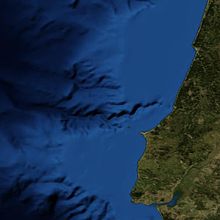
Garrett McNamara of Hawaii rode a giant wave in Nazaré, Portugal yesterday.
It was claimed to be 100 feet high, although the Guiness Book of World Records has not yet confirmed the measurement.
Nazaré has unusual conditions for making huge waves … an undersea trench narrows right before the shore, shooting the sea up to the sky at the last minute.
After McNamara set his prior world record at Nazaré in 2011, he explained:
“There is an underwater canyon 1,000ft deep that runs from the ocean right up to the cliffs. It’s like a funnel. At its ocean end it’s three miles wide but narrows as it gets closer to the shore and when there is a big swell it acts like an amplifier.”
***
Big wave surfing requires special equipment and a different approach to riding ordinary waves. On 1 November McNamara was equipped with a buoyancy aid and knee braces to protect his joints from the battering a surfer’s legs suffer bouncing down the huge wave faces.
“It looks smooth but it’s not. It’s like bouncing down moguls [on a ski slope]. You hit every ripple in the water.” It is for precisely this reason that in the huge sets, the second wave is often preferable. “The first wave grooms the sea bottom and can make the second smoother,” McNamara explains.
On 1 November McNamara was not equipped with an emergency air supply to improve his chances of survival if he were to be held down by the surging water after coming off his board. His 6ft board is equipped with feet straps, like a snowboard, to prevent him being thrown off, and loaded with 10lbs (5kg) of extra weight to increase momentum at the beginning of the ride. Even catching big waves is different to ordinary surfing. The speed of big waves makes it difficult to paddle fast enough ahead of the wave to catch them, so jetskis are used to tow the surfer at speed on to the breaking crest and to recover the surfer at the end of his ride – a dangerous business in its own right.
Here is a trailer for a coming movie on McNamara’s world record ride yesterday:

http://www.washingtonsblog.com/

